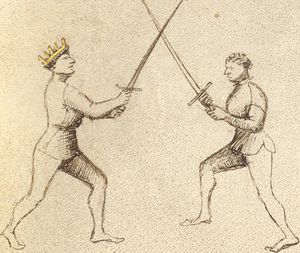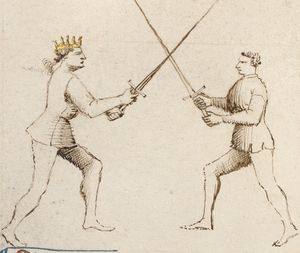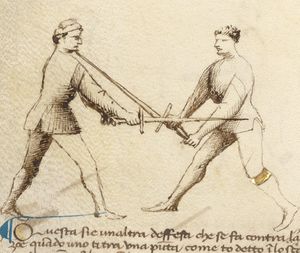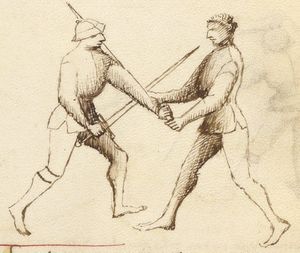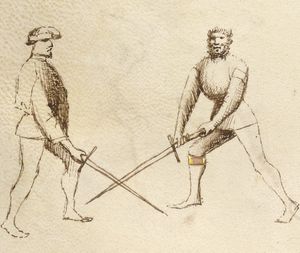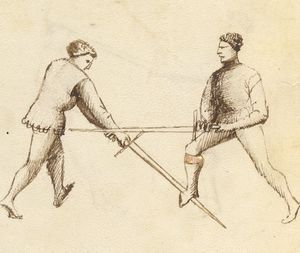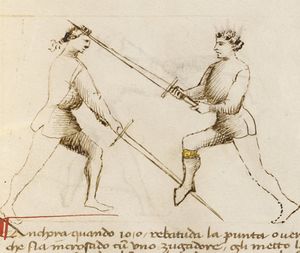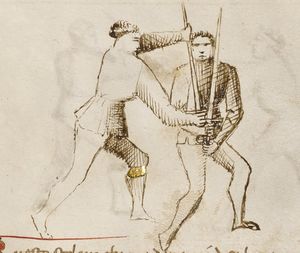|
|
You are not currently logged in. Are you accessing the unsecure (http) portal? Click here to switch to the secure portal. |
Fiore de'i Liberi/Sword in Two Hands/Wide Play
Images |
Images |
PD |
[[Fior di Battaglia (MS M.383)|Morgan Transcription |
Getty Transcription |
|||
|---|---|---|---|---|---|---|---|
| [No Image] |
[26] The Sword, I am mortal against any weapon; no spear, no pollaxe, no dagger, is effective against me; long or short I can do. And I will come to the Close Play; and come to sword disarms and to wrestling; with my art I can do breaks and binds, I know well how to make covers and injuries; always in these I want to finish. I will make those who fight against me weep. And I am Royal and I maintain the justice; I increase goodness and I destroy malice. Those who will look at me making my crosses, of facts of armed combat I will make famous and vose. |
[25r-t] ¶ Spada son contro ogni arma mortale, ne Lanza ne Azza ni daga contra mi vale. Longa e curta me posso fare. e me strengho e vegno alo zogho stretto, e'vegno allo tor de spada e allo abrazare mia arte si'e roture e ligadure so ben fare de coverte e ferire sempre in quelle voglio finire, chi contra me fara, ben lo faro languire. E son Reale e'mantegno la Justicia, la bonta acresco e destruzo la malicia. Chi me guardera fazendo in me crose, de fatto de armizare gli faro fama e vose. |
|||||
[27] By crossing with you at the tip of the sword Here commences play of the two-handed sword, Gioco Largo (Wide Play). This Master, who crosses with this player, in the point of sword, says, "when I am crossed in point of sword, I immediately turn (volta) my sword and I injure him from the other side, with a fendente downwards into the head and arms, or I thrust him in the face, as you see drawn after". [In the Pisani Dossi, the player is wearing a crown.] |
Here begins the wide play of the sword in two hands with a little crossing; the honor will be to whoever will know to make it. This Master that is here crossed with this player says "When I am crossed at the tip of the sword, I quickly give a turn to my sword and thus I strike with a downward blow from the other side (that is, through the head and through the arms), or I thrust the point into his face as you see hereafter in my depiction." [In the Paris, both Masters have their right feet forward. In the Morgan, the player is wearing a garter and crown.] |
[13v-t] Aqui comenza zogo largo de spada a doe mane cum pocho incrosare, lo honore sera de chi meio savera fare. [13v-a] Questo magistro ch'e aqui incrosado cum questo çugadore dise quando io sono incrosado in punta de spada subito io do volta ala mia spada, e si lo fiero del'altra parte cum lo fendente zoe per la testa, e per gli brazi, overo o ch'io gli metto una punta in lo volto. Como vuii vederite qui de dredo da mi dipento. |
[25r-c] ¶ Qui cominza zogho di spada a doii man zogho largo. Questo magistro ch'e qui incrosado cum questo zugadore in punta de spada, dise quando io son incrosado in punta de spada, subito io do volta ala mia spada e si lo fiero dal'altra parte cum lo fendente zo per la testa e per gli brazzi, overo che gli metto una punta in lo volto, come vederi qui dredo depinto. |
[19b-a] Per incrosar cum ti a punta de spada |
[14r-a] ¶ In cruce compressam teneo cum cuspide spatam. ☜ | ||
[28] With the strike of which the Master spoke who came before, I positioned a thrust in your face, like the master which was before said. Also, I could have done what he says, that is, retract my sword immediately when I was crossed by the right side: I had to turn my sword on the left side in a fendente to the head and arms, like my Master said, who was before me. |
I have set my point in his face as said my Master who came before. Also, I could have made the [other] play that he said, that is, to have attacked with my sword immediately when I was beside the crossing of the right side: from the other side, that is from the left, I should have immediately turned my sword into a downward blow to the head and to the arms, as has said my Master that came before. |
[13v-b] Io te ho posto una punta in lo volto, como lo mio magistro ch'e denanci dise. Anchora poria avere fato zo ch'ello dise, zoe avere trato de mia spada, subito quando io era apresso lo incrosare della parte dritta dell'altra parte zoe della stancha io debeva voltare subito la mia spada in lo fendente per in la testa e per gli brazi como ha ditto lo magistro mio ch'e denanci. |
[25r-d] ¶ Io t'o posta una punta in lo volto come lo magistro ch'e denanci dise. Anchora poria aver fatto zo ch'ello dise zoe aver tratto de mia spada subito quando io era apresso lo incrosare dela parte dritta. del'altra parte zoe dela stancha io debeva voltare la mia spada in lo fendente per la testa e per gli brazzi, como a ditto lo mio magistro ch'e denançi. |
[19b-b] Per lo ferir che dise el magistro ch'e denançi posto |
[14r-c] ¶ Audito sermone mei nunc ante magistri | ||
[29] By crossing at mid-sword, I will strike your left arm; Again, I am crossed at Gioco Largo at the middle of the blade. And immediately when I cross [swords], I let my sword slip over his hands, and if I want to pass with my right foot out of the way, I can deliver a thrust in his chest, as is drawn hereafter. [In the Pisani Dossi, the player is wearing a crown.] |
Again I am crossed here for the long play, at mid-sword. And immediately when I am crossed, I allow my sword to run off over his hands, and if I want to step out of the way with my right foot, I can thrust my point into his chest as is depicted hereafter. [In the Morgan, the player is wearing a garter and crown.] |
[13v-c] Anchora me incroso qui per zogo largo, a meza spada. E subito quando io sono incrosado io lasso discorere la mia spada sopra le suie mane, e se voglo passare cum lo pe dritto fora de strada io gli posso mettere una punta in lo petto come vui vedite qui dredo dipento. |
[25v-a] ¶ Anchora me incroso qui per zogho largo a meza spada. E subito che son incrosado, io lasso discorrer la mia spada sopra le soi mane, e se voglio passare cum lo pe dritto fuora de strada, io gli posso metter una punta in lo petto, come qui dredo e depento. |
[19b-c] Per incrosar a'meça spada el braço stancho te feriro |
[14v-a] ¶ In medio nunc ense tenens ego callidus ensem | ||
[30] From the Master who crosses at mid-sword, The play of my master has been completed, because I have done his cover, and immediately done what he said, that first I have injured the arms, then I have positioned the point/thrust in his chest. |
The play of my Master I have completed, in that I have made his cover and I have quickly executed his saying: I have struck first his arms, and then I have placed my point in his chest. |
[13v-d] Lo zogho delo mio magistro io l'o compido, che i'o fatto la sua coverta. E subito, o fatto el suo ditto. Che i'o feridi prima gli brazi, e poii gle ho posta la punta in lo petto. |
[25v-b] ¶ Lo zogho del mio magistro io l'o complido, che io o fatta la sua coverta, e subito o fatto lo suo ditto, che io o'ferido prima gli brazzi, e poii gl'o posta la punta in petto. |
[19b-d] Per lo magistro che incrosa a'meça spada |
|||
[31] Also from this same crossing My Master, who is before, taught me that when I am crossed in the middle of the blade, I have to immediately step forward (acresser inanci) and grab his sword, to wound with a cut or a thrust. Also, I can incapacitate his leg in the way you can see drawn here by injuring him with my foot over the back of the leg or under the knee. |
My Master who came before has taught me that when I am crossed at the mid-sword, I should immediately advance forward and grab his sword (as in this match) in order to strike him with edge or point. Also, I can waste his leg in the way that you will be able to see depicted hereafter by striking with my foot over the back of his leg or under his knee. |
[14r-a] Ello mio magistro che m'e denanci m'a insegnato che[3] quando a meza spada io son cum uno incrosado che subito me debia acresere in denanci e piglare la sua spada a questo partito, per ferirlo taglo, o punta. Anchora gle posso guastare la gamba per lo modo che voi possete vedere aqui dipento a ferirlo cum pe sopra la schena della gamba, overo sotto lo zinochio. |
[25v-c] ¶ El mio magistro ch'e denanzi m'a insegnado che quando a meza spada io son cum uno incrosado che subito mi debia acresser inanci, e piglar la sua spada a questo partido per ferirlo taglo o punta. Anchora gli posso guastar la gamba per lo modo che possi vedere qui depento a ferirlo cum lo pe sopra la schena dela gamba overo sotto lo zinochio. |
[20a-a] Anchora per quello proprio incrosare |
|||
[32] There is no question of the saying of the earlier Master, The student which is before says that his Master, and mine, taught him this play, and for ________ I do it. There is no problem for me to do it easily. |
The Scholar who came before me says of his Master and mine that he has taught this play, and I do it to crumple [my opponent]. Without a doubt, to do it is little trouble to me. |
[14r-b] Lo scolar che m'e denanzi dise del suo magistro, e mio che llo gle ha insignado questo zogo, e per vezuda io lo fazo. A farlo senza dubio ello m'e pocho impazo. |
[25v-d] ¶ Lo scholaro che m'e denanzi dise del suo magistro e mio ch'ello gli ha insegnado questo zogho, e per vizuda io lo fazo. A farlo senza dubio, ello m'e pocho impazo. |
[20a-b] Lo dito del magistro denançi de quello non ne questione |
|||
[33] I have uncovered you well by stepping out of the way This play is called colpi di villano ('Peasant Strike'), and is made in this way. That is, you have to wait for the villano to strike with his sword, and the one who is waiting has to stay in little pass with the left foot advanced. And immediately when the villano attacks to wound, step forward/advance (acresse) with your left foot out of the way, towards the right side. And with the right foot pass traversing out of the way, taking his blow in the middle of your sword. And let slide his sword groundwards, and immediately respond with a fendente in the head or in the arms, or with a thrust to his chest, as is drawn. Also, this play is also good with a sword against an pollaxe, against a big stick, serious or liziero (practice?). [In the Getty, the Master is missing his crown.] |
This play is called the Villain's Strike (Colpo del Vilano) and is made in this way, that is, that one should await the villain in this way until he strikes with his sword. And he that awaits the blow should stand in a small stance with the left foot forward. And in that moment when the villain attacks to harm you, advance your left foot out of the way toward the right side. And with your right foot step out of the way to the side, catching his blow at the mid-sword and allowing his sword to run off toward the ground, and then quickly respond with a downward blow (through the head or through the arms) or with your point in the chest as depicted here, this is also good. [In the Morgan, the Master is missing his crown.] |
[14r-c] Questo zogo e chiamado lo colpo del vilano, e si fa per tal modo. Zoe che si de aspetare lo vilano ch'ello traga cum sua spada. E quello che aspeta lo colpo di stare in picolo passo cum lo pe stancho denanci. E in quello che lo vilano te tra per ferirte. Acrese lo pe stancho fora de strada inverso la parte dritta. E cum lo dritto pe passa ala traversa fora de strada, piglando lo suo colpo a meza spada e lassa discorere la sua spada a terra, e subito respondigli cum lo fendente per la testa overo per gli brazi overo cum la punta in lo petto come qui dipento. ancora questo e bono. |
[26r-a] ¶ Questo zogho si'e chiamado colpo di villano e sta in tal modo, Zoe che si de aspettare lo villano che lo traga cum sua spada. E quello che lo colpo aspetta de stare in picolo passo cum lo pe stancho denanzi. E subito che lo villano ti tra per ferire, acresse lo pe stancho fora de strada inverso la parte dritta, E cum lo dritto passa ala traversa fora de strada pigliando lo suo colpo a meza la tua spada. E lassa discorrer la sua spada a terra, e subito responde gli cum lo fendente per la testa overo per gli brazi, overo cum la punta in lo petto come depinto. Anchora e questo zogho bon cum la spada contra la Azza, e contra un bastone grave o liziero. |
[20a-c] Per passar fora de'strada io t'o ben discoverto |
|||
[34] The strike to your arms, that play I make, This before me is the colpo del villano ('Peasant Strike'), which I have positioned my point/thrust in his chest well. And in the same way, I could have made a blow at his head and at his arms with a fendente, as said before. Also, if the player wants against me to injure me with the riverso under my arms, I immediately step forward/advance (acresco) the left foot, and put my sword over his, and he can do nothing to me. |
This is the Villain's Strike which appeared here before me, so that I have put my point into his chest well. And so I could [also] have made a cut through the head and through the arms with a downward blow as was said before. Also, if the player wanted to come against me such that he would strike me with a backhand blow under my arms, I would immediately advance my left foot and thrust my sword over his, and then he cannot do anything to me. |
[14r-d] Questo e lo colpo del vilano ch'e qui denanci de mi. Che bene gle ho posta la punta in lo petto. E cosi gle posseva fare uno colpo per la testa, e per gli brazi cum lo fendente como e ditto denanci. Ancora s'eio[!] volesse lo zugadore contra de mi fare che ello volesse ferirme cum lo riverso sotto gli mie brazi. Io subito acrescho lo pe stancho e meto la mia spada sopra la sua, e non mi po far niente. |
[26r-b] ¶ Qui denanci si'e lo colpo del villano, che ben gl'o posta la punta in lo petto. E cossi gli posseva un colpo per la testa fare e'per gli brazzi cum lo fendente comme ditto denanzi. Anchora se'l zogadore volesse contra de mi fare volendo mi ferire cum lo riverso sotto gli miei braççi, io subito acresso lo pe stancho, e metto la mia spada sopra la sua. e non mi po far niente. |
[20a-d] Lo ferire deli braçi aquello zogho te faço |
|||
[35] When a sword flies for your leg When someone strikes to your leg, step back/slip (discresse) with your forefoot. You retreat backwards and strike a fendente in his head as shown here. With a two-handed sword you can not strike well from the knee downwards, because it is very dangerous for the one who strikes, because the one who attacks the leg remains all uncovered. Unless one has fallen on the ground, then he can injure the leg well, otherwise you can not, being sword against sword. |
When one strikes for your leg, withdraw the foot that is forward or return it behind, and throw a downward blow to his head as depicted here. Note that the sword in two hands should not attack from the knee down, because the danger to he that attacks is too great. He that attacks for the leg remains wholly uncovered, unless he would drop to the ground—then he could strike the leg well, but otherwise [he could] not when fighting sword to sword. |
[14v-a] Quando uno te tra per la gamba, discrese lo pe ch'e denanci. O tu lo torna indredo e tra dello fendent per la sua testa. Come aqui dipento. Ben che cum spada a doe mane non se de trare dello genochio in zu, perche e tropo grande pericolo aquello che tra. Che lo romane tuto discoverto quello che tra per la gamba. Salvo che se uno fosse cazuto in terra, ben se poria trar per gamba. Ma altramente non stando spada contra spada. |
[26r-c] ¶ Quando uno te tra per la gamba, discresse lo pe ch'e denanzi. O tu lo torna in dredo. e tira del fendente per sua testa come qui depento. Ben che cum spada de doii man non si de trare del zinochio in zu. Pero ch'e troppo grande pericolo a choluii che tra. Ch'ello rimane tutto discoverto quello che tra per gamba. Salvo che se uno fosse cazudo in terra poria si ben trar per gamba. Ma altra mente no, siando spada contra spada. |
[20b-a] Quando la spada per la gamba si volla |
|||
[36] When I am crossed with someone and come to the narrow, This partido (division/finish) I will do, with my foot in your bollocks, I do it to cause you pain, and to make you loose the cover. Because this play has to be done immediately, not to have doubts against it. The counter to this play has to be done quickly, which is; the player has to grab the student's right leg with his left hand, and he can throw him to the ground. |
In this match I strike you with my foot in your testicles, and I do it to give you pain and to make your cover waver. Thus, in making this play I want to do it suddenly so that the counter is doubtful. The counter of this play wants to be made quickly, such that the player should catch the Scholar by the right leg with his left hand, and then he can throw him to the ground. |
[14v-b] Aquesto partito che io te fiero cum lo pe in gli coglura el fazo per farte doia, e per farte svariarte la coverta che fazando questo zogo vole essere fato subito, per non aver dello contrario dubito. Lo contrario de questo zogo vole essere presto fatto zoe che lo zugadore de piglare per la gamba dritta lo scolaro, cum sua mane stancha e in terra lo po butare. |
[26r-d] ¶ Questo partido che io ti fiero cum lo pe in li cogloni el fazo per far te doglia e per far te svariare la coverta. Che fazando questo zogho vol esser fatto subito, per non avere del contrario dubito. Lo contrario di questo zogo vol esser presto fatto, zoe che lo zugador de piglare per la gamba dritta lo scolaro cum sua mano stancha, e in terra lo po buttare. |
[20b-b] Quando io me incroso cum uno e'vegno al'streto |
|||
[37] This is a cruel exchange of thrusts: This play is called 'Exchanging Thrusts' (scambiar de punta), and you have to do it in this way: When someone delivers you a thrust, immediately step forward/advance (acresse) your forefoot, out of the way, and with the other foot pass traversing (a la traversa) again out of the way, crossing (traversando) his sword with your arms lowered and with the point of your sword high, to his head or his chest, as is drawn. |
This play, which is called the Exchange of Thrusts (Scambiare de Punta), is made in this way, that is, that when he attacks with the point, quickly advance your forward foot out of the way and with your other foot step to the side (also out of the way), crossing his sword with your arms low and with the point of your sword up in his face or in his chest, as is depicted here. |
[14v-c] Questo zogo che se chiama scambiare de punta, e se fa per tal modo zoe quando te tra una punta subito acrese lo tuo pe denanci fora de strada a cum l'altro pe passa ala traversa anchora fora de strada, atraversando la sua spada cum gli toii brazi bassi, E cum la punta dela spada erta in lo volto o in lo petto come e aqui dipento. |
[26v-a] ¶ Questo zogho si chiama scambiar de punta e se fa per tal modo zoe. Quando uno te tra una punta. subito acresse lo tuo pe ch'e denançi fora de strada, e cum l'altro pe passa ala traversa anchora fora di strada, traversando la sua spada cum cum[4] gli toi brazzi bassi, e cum la punta dela tua spada erta in lo volto o in lo petto come depento. |
[20b-c] Aquesto e de punta un crudelle schambiar |
[15r-a] ¶ Si subito nostrum ludendo vertimus ensem / | ||
[38] Because of your hilt, which I hold in my hand, From this Exchanging Thrusts which is before me, comes this play. That immediately that the student which is before me does not stab the thrust in the face of the player, and letting it not be delivered in the face or chest, and because it was that the player was armoured, immediately this student has to pass forward with his left foot, and he has to grab in this way. And he can injure him well with his sword, because the player has grabbed his sword and can not flee. |
From this exchange of thrusts that came before me comes this play. Given that the Scholar who came before me did not immediately thrust his point into the face of the player, or that he failed such that he could not thrust into [the player's] face nor into his chest, or that the player was armored, then immediately the Scholar should step with his left foot forward, and he should grab [the player] in this manner, and his sword should throw a good strike because the player has his sword caught and he cannot flee. |
[14v-d] De questo scambiar de punta che m'e denanci essi aquesto zogo. Che subito lo che lo scolar che m'e denanci non metesse la punta in lo volto delo zugadore ch'ello la falasse ch'ello non la metesse in lo volto ne in lo petto, o perche fosse lo zugadore armato. Subito debia lo scolar cum lo pe stancho innanci passar. E per questo modo lo debia piglare, e la sua spada metero[!] a bon ferire, po che lo zugadore e presa sua[5] spada non po fuzir. |
[26v-b] ¶ De questo scambiar de punta che m'e denanzi, essi questo zogho, che subito che lo scolar che m'e denanzi non metesse la punta in lo volto del zugadore, e'lassasela si'che non la metesse ne in lo volto ne in lo petto, e per che fosse lo zugador armado, Subito debia lo scolaro cum lo pe stancho inanci passare, e per questo modo lo debia piglare. E la sua spada metter a bon ferire poii che lo zugador a presa sua spada e non po fuzire. |
[20b-d] Per tuo mantigner che io in mia man tegno |
[15r-c] ¶ Quamvis me teneas manibus / quid proderitur. Hac te | ||
[39] Here we stand crossed near the ground: This is another defence to do against a thrust, which is when someone delivers a thrust at you, as I told you in the Exchanging Thrusts, in the second play which is before me, you have to step forward/advance (acresser) and pass out of the way. In the same way you have to do this play, except that the Exchanging Thrusts goes with a thrust, and with the arms lowered, and with the point of the sword high as I said before. But this is called 'Breaking Thrust' (rompere de punta), because the student goes with his arms high, and snatches [gives] a fendente in stepping forward (acresser) and passing out of the way, and strikes across the thrust, nearly to the middle of the sword, to beat (rebaterla) it to the ground. And immediately comes to the close. |
[The Paris resembles the Pisani-Dossi image.] |
[26v-c] ¶ Questa si'e un'altra deffesa che se fa contra la punta zoe quando uno ti tra una punta come t'o detto in lo scambiar de punta in lo segondo zogo che m'e denanzi che se de acresser e passar fora di strada. Chossi si die far in questo zogho, salvo che lo scambiar de punta se va cum punta e cum gli brazzi bassi e cum la punta erta dela spada come detto denanzi. Ma questo se chiama romper de punta che lo scolaro va cum gli brazzi erti e pigla lo fendente cum lo acresser e passare fora de strada e tra per traverso la punta quasi a meza spada a rebater la a terra. E subito vene ale strette. |
[21a-b] Aqui stasemo noii a terra incrosadi |
[15v-a] ¶ In forma crucis hic nos nunc luctando manemus. | |||
[40] I beat your point to the ground very quickly The student which is before me has beaten the player's sword to the ground, and I complete his play in this way. Having beaten his sword to the ground, I put my right foot strongly onto his sword. I can break it, or I can grab it in a way that he can not ___ any more. And if this is not enough for me, immediately when I put my foot on his sword, I injure him with the false edge of my sword, under his beard, in his neck. And immediately I return with a fendente of my sword, to his arms or to his hands, as is drawn. [In the Pisani-Dossi, the Scholar stomps with his left foot and his opponent's right foot is forward; the Scholar's opponent is also left-handed.] |
[26v-d] ¶ Lo scolaro che m'e denanzi a rebatuda la spada del zugador a terra. & io complisco lo suo zogho per questo modo. Che rebattuda la sua spada a terra, io gli metto cum forza lo mio pe dritto sopra la sua spada. Overo che io la rompo, o la piglo per modo che piu non la pora curare. E questo non me basta, che subito quando gl'o posto lo pe sopra la spada, Io lo fiero cum lo falso dela mia spada sotto la barba in lo collo. E subito torno cum lo fendente dela mia spada per gli brazzi o per le man come depento |
[21a-a] Rebati tua punta in terra ben subito |
[15v-d] ¶ Nunc tua per terram subito manus impia puntam | ||||
[41] From the crossing at the ground which the Scholar makes Again, this is a play of Breaking Thrust, which is as the second play which is before me. That when I have beaten (rebatuda) the sword to the ground, I immediately put my right foot on his sword. And in that deed, I injure him in the head, as you can see. [In the Pisani-Dossi, the Scholar stomps with his left foot and his opponent's right foot is forward.] |
[27r-a] ¶ Anchora questo zogho del romper di punta ch'e lo segondo zogho che m'e denanzi. Ch'e quando io o rebattuda la spada a terra, subito io fiero cum lo pe dritto sopra la sua spada. E in quello ferire io lo fiero in la testa come voii vedete. |
[21a-c] Per lo incrosar de terra che fa lo scolar |
|||||
[42] From the play that came before, I enter into this one: This is also another play of Breaking Thrust, because if the player being broken (because I have broken his thrust), lifts his sword to cover from mine, then I immediately put the pommel of my sword in the part of his right arm near his right hand. And then I immediately grab my sword with my left hand near the point, and I injure the player in his head. And if I want, I can put it to his neck, to slice the windpipe of his throat. |
[27r-b] ¶ Questo e anchora un altro zogho del romper de punta, che si lo zugadore in lo rompere ch'i'o rotta la sua punta, leva la sua spada ala coverta dela mia subito io gli metto l'elzo dela mia spada dentro parte del suo brazo dritto apresso la sua mane dritta, E subito piglo la mia spada cum la mia man mancha a presso la punta, e fiero lo zugadore in la testa. E se io volesse, metteria la al collo suo per segargli la canna dela gola. |
[21a-d] Del çogho ch'e denançi entro inquesto |
|||||
[43] I will make you turn by pinching your elbow Also, when I have beaten back the thrust, or when I am crossed [swords] with a player, I put my hand behind his right elbow, and I pinch it strongly in a way that makes him turn and uncover himself, and then I injure him in that turning I make him do. |
[27r-c] ¶ Anchora quando io, o, rebatuda la la punta o vero che sia incrosado cum uno zugadore, gli metto la mia mane dredo al suo cubito dritto, e penzolo forte per modo che io lo façzo voltare e discovrire, e poii lo fiero in quello voltare, che io gli faço fare. |
[21b-a] Per pinçer lo tuo cubito io te'faro voltar |
|||||
[44] Because of the turn that I have given you by the elbow This student who is before me, says the truth, because of the turn he makes you do. In this way, I will cut you in the back of your head. Also, before you could return to your cover, I could give you an open wound in your back with a thrust. |
[27r-d] ¶ Questo scolaro che m'e denanzi dise lo vero che per la volta ch'ello ti fa fare per questo modo dredo de ti la testa ti vegno a taglare. Anchora inanzi che tu tornassi ala coverta, Io ti poria fare in la schena cum la punta una piaga averta. |
[21b-b] Per la volta che t'o dada per lo cubito |
|||||
[45] I appear to come from the right, but I enter on the left This play is called 'False Thrust' (punta falsa) and 'Short Thrust' (punta curta), and I will tell you how I do it. I pretend to come with a great force to injure the player with a mezano blow in his head, and immediately when he does the cover, I strike his sword lightly. And immediately turn (volto) my sword on the other side, grabbing my sword almost in the middle with my left hand, and immediately I put the point/thrust in his throat or chest. And this play is better in armour than without. [The Getty resembles the Pisani-Dossi image.] |
[27v-a] ¶ Questo zogo si chiama punta falsa e punta curta, e si diro come la fazzo. Io mostro de venire cum granda forza per ferir lo zugadore cum colpo mezano in la testa. E subito ch'ello fa la coverta, io fiero la sua spada lizera mente. E subito volto la spada mia del'altra parte piglando la mia spada cum la mane mia mancha quasi al mezo. E la punta gli metto subita in la gola o in lo petto. Ed'e miglore questo zogo in arme che senza. |
[21b-c] Mostraii de'vegner dal drito in lo riversso intraii |
[28v-c] ¶ Obliquam in partem recta d(e?) parte subivj. | ||||
[46] To the Deceitful Thrust that you wanted to strike at me, This is the counter to the play before me, which is False Thrust, or Short Thrust. And this counter is done in this way; when the student strikes my sword, in that turning he does with his sword, I immediately turn mine in the way he is turning his, but I pass across/to the traverse, to find the fellow more uncovered. And then I put my point in his face. And this counter is good in armour and without. |
[27v-b] ¶ Questo si'e lo contrario del zogho che m'e denançi, zoe de punta falsa overo di punta curta. E questo contrario si fa per tal modo. Quando lo scolaro fieri in la mia spada, in la volta ch'ello da ala sua spada Subito io do volta ala mia per quello modo che lui da volta ala sua. Salvo che io passo a la traversa per trovar lo compagno piu discoverto. E si gli metto la punta in lo volto. E questo contrario e bono in arme e senza. |
[21b-d] Per punta falssa che tu me volisti ferir |
|||||
| [No Image] |
[47] Here finishes the Gioco Largo (Wide Play) with the two-handed sword, which has united plays, which has plays that are the remedies and counters from the right and from the left sides, and counter-thrusts, and counter-cuts for every reason, with breaks, covers, injuring and binds; which are things that are all easily understandable. |
[27v-c] ¶ Qui finisse zogho largo dela spada a doii mani, che sono zoghi uniti gli quali ano zoghi, zoe rimedii e'contrarii da parte dritta, e de parte riversa. e contra punte e contra tagli de zaschuna rasone cum roture coverte, ferire e ligadure, che tutte queste chose liçerissima mente se pono intendere. |

